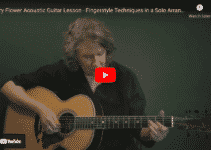This past summer, I had the incredible luck to do a bunch of shows with Tommy Emmanuel, both opening for him and playing duets together. As I watched Emmanuel from behind the stage during his sets, I was struck by the diversity of his playing—so many styles and techniques beautifully blended together.
That experience inspired me to broaden the languages and devices on the title track I was writing for my new album, Through the Years. The idea was to try to expand the simple melody I had for the A section into a more progressive, multi-stylistic composition, so I used some of the tools I knew would work well for this purpose: interesting key changes and techniques, variations, fills, and a solo section with some “wow” effect. Let me share these concepts with you, so that you can use them in your own writing and arranging.
Theme Exposition and Variations
The song “Through the Years” begins with a super-easy melody, as shown in Example 1 (below), that starts with no tempo and only a skeletal outline of the chords. I play it through once and then introduce a variation, which includes a rhythm movement of the right hand plus a snare-drum effect with the thumb and some harmonics as garnish (Example 2). To produce the snare sound, I raise and hit the E or A string with my thumb. I choose the string depending on the root of the chord, so that I have the bass ready to pick after the hit.
This is a simple alteration of the initial theme, but it works like a charm. Anything that can make it sound fresh the next time around is the objective, and the absence and then introduction of the rhythmic backbone does the job perfectly. In the case of solo acoustic guitar, sometimes you need to take stuff away to make it pop when you reintroduce it, and to create diversity.
The third time I play the theme, I introduce some fills to refresh the melody—Jimi Hendrix–inspired ornamentation, double stops with slides—approaches borrowed from the electric guitar world (Example 3). These devices make the piece more, shall we say, guitar-nerd-friendly, without being all that difficult to play.
Tempo Changes
Wanting to create a varied piece of music, I thought that a B section with a completely different tempo would be nice, something that a progressive rock band like Genesis might do. So I introduced a faster-paced section, actually more than double the tempo of the previous one. As indicated in Example 4, this section also falls in an interesting metric division, with three bars of 4/4 and one of 2/4. In my perception, this makes the acceleration of this portion of the composition even more compelling.
Tempo changes can be tricky for both the player and the audience, so the real challenge is to write something that feels natural. Every time it comes across as forced or showy, it instantly becomes annoying. If it’s well written, it will become easy to execute with a bit of slow and careful practice.
The Wow Factor
I think there is nothing wrong with showing off a little. We love some of our favorite players—whether Tommy Emmanuel, Eddie Van Halen, or Pat Metheny—because in one way or another they introduce some excitement in their music through advanced technique. To me, it’s just a push on the pedal, a show of bright lights on a stage. The solo section of “Through the Years” is inspired by a part electric guitar virtuoso Steve Vai plays on a movie that I loved as a kid, Crossroads. Vai’s piece is in turn patterned after the end of the Niccolò Paganini’s violin composition “Capriccio No. 5.”
The trick for these kinds of things is to find a cool technique that has a nice amount of wow factor and milk it as much as is musically possible. So I do a series of pull-offs to the open first string, all within the E major scale (E F# G# A B C# D#), increasingly widening the movements on the fretboard to obtain an exciting buildup (Example 5).
To do Ex. 5, it’s very important to be able to play it very strongly at a much slower tempo, building speed only after the timing and uniformity are there. The reverse is, as always, impossible.
Key Changes and Harmonic Subtleties
Getting back to the B section, let’s take a look at how it develops harmonically. As shown in Example 6, I tried to include some interesting variations, especially to have it contrast with the simplicity of the A section, which is really diatonic and moves about the E major key. The B part starts with a Lydian vibe, with a raised fourth (D#) over the A chord (bar 1).
So we are actually still in E major, until the little double-stop lick, with its natural D, plays out. That takes us briefly to A major. Then, in bar 5, there’s an Emaj9 chord, with its D#, taking us back to E major. That little D-to-D# change is subtle, but it’s like a little spice you throw on a finished dish—here, try this with a little paprika.
Bars 9–12 move to A minor for a change of color, and then to E Mixolydian in bars 13–14, thanks to the Dadd9/E chord. In the last two measures, there’s a return to A minor, but I end on a very reassuring E major chord on the “and” of beat 4, just before the vocals come in on the studio recording.
Head spinning? No worries—the purpose is not to make things difficult, but to make them interesting. I wrote “Through the Years” spontaneously, without even thinking about theory, and am only now using it to explain my harmonic choices. I really hope you got something out of this analysis, and of course you can check out my record in full to see all these tools at work. Ciao!
Alberto Lombardi is a guitarist, singer-songwriter, producer, and teacher based in Rome, Italy.


This article originally appeared in the May/June 2023 issue of Acoustic Guitar magazine.



